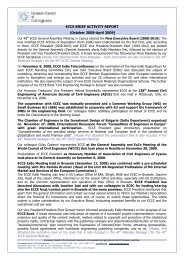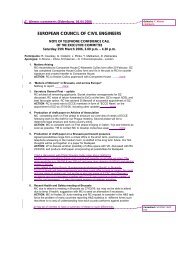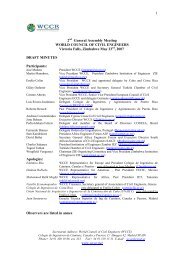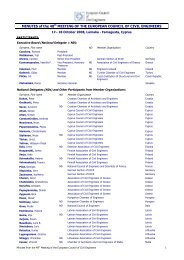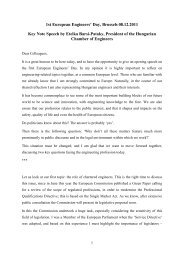A Closer Look at Prevailing Civil Engineering Practice - European ...
A Closer Look at Prevailing Civil Engineering Practice - European ...
A Closer Look at Prevailing Civil Engineering Practice - European ...
Create successful ePaper yourself
Turn your PDF publications into a flip-book with our unique Google optimized e-Paper software.
A <strong>Closer</strong> <strong>Look</strong> <strong>at</strong> <strong>Prevailing</strong> <strong>Civil</strong> <strong>Engineering</strong> <strong>Practice</strong>, Wh<strong>at</strong>, Why and How<br />
Vincent T. H. CHU<br />
where t = Pipe thickness<br />
F = Factor of Safety of 2<br />
P = Working pressure<br />
S = Surge pressure<br />
Y = Yield strength of ductile iron<br />
For steel pipes the design of working pressure is based on 50% of steel<br />
yield strength (i.e. a factor of safety of 2). The presence of surges could be<br />
allowed to increase the stress in pipe to 75% of yield strength. The design<br />
is based on the following steps:<br />
(A) If surge pressure is less than or equal to one-half of working pressure,<br />
the pipe shall be designed using working pressure only with 50% yield<br />
strength as allowable stress.<br />
PD<br />
t = where Y = 50% of yield strength<br />
2Y<br />
(B) If surge pressure is more than or equal to one-half of working pressure,<br />
the pipe shall be designed using working pressure and surge pressure<br />
only with 75% yield strength as allowable stress.<br />
( P + S)<br />
D<br />
t = where Y = 75% of yield strength<br />
2Y<br />
For case A, the use of 50% yield strength is essentially the same of<br />
adopting a safety factor of 2 in DI pipe design. However, as surge pressure<br />
is not considered, the thickness calcul<strong>at</strong>ed is smaller than th<strong>at</strong> in DI pipe<br />
design.<br />
For case B, the use of 75% yield strength is essentially the same of<br />
adopting a safety factor of 1.33 in DI pipe design. As such, the thickness<br />
calcul<strong>at</strong>ed is smaller than th<strong>at</strong> in DI pipe design.<br />
9. Wh<strong>at</strong> are the controversial health issues of using asbestos cement<br />
pipes for w<strong>at</strong>ermain<br />
There are suspected health hazard for using asbestos cement pipes for<br />
w<strong>at</strong>ermain. In drinking w<strong>at</strong>er the gastrointestinal tract cancer risk depends<br />
on the amount of asbestos swallowed. When asbestos cement pipes are in<br />
good condition, there should be little safety problem. However, when the<br />
73








